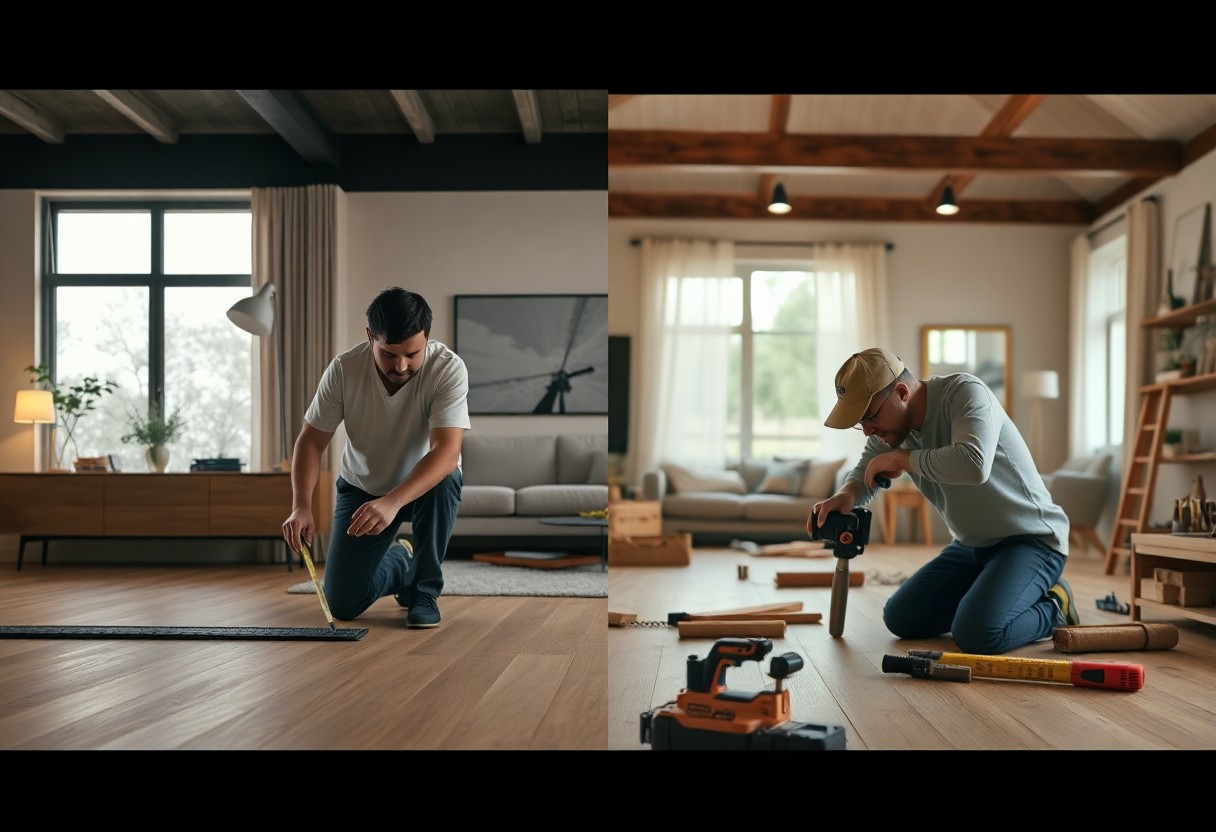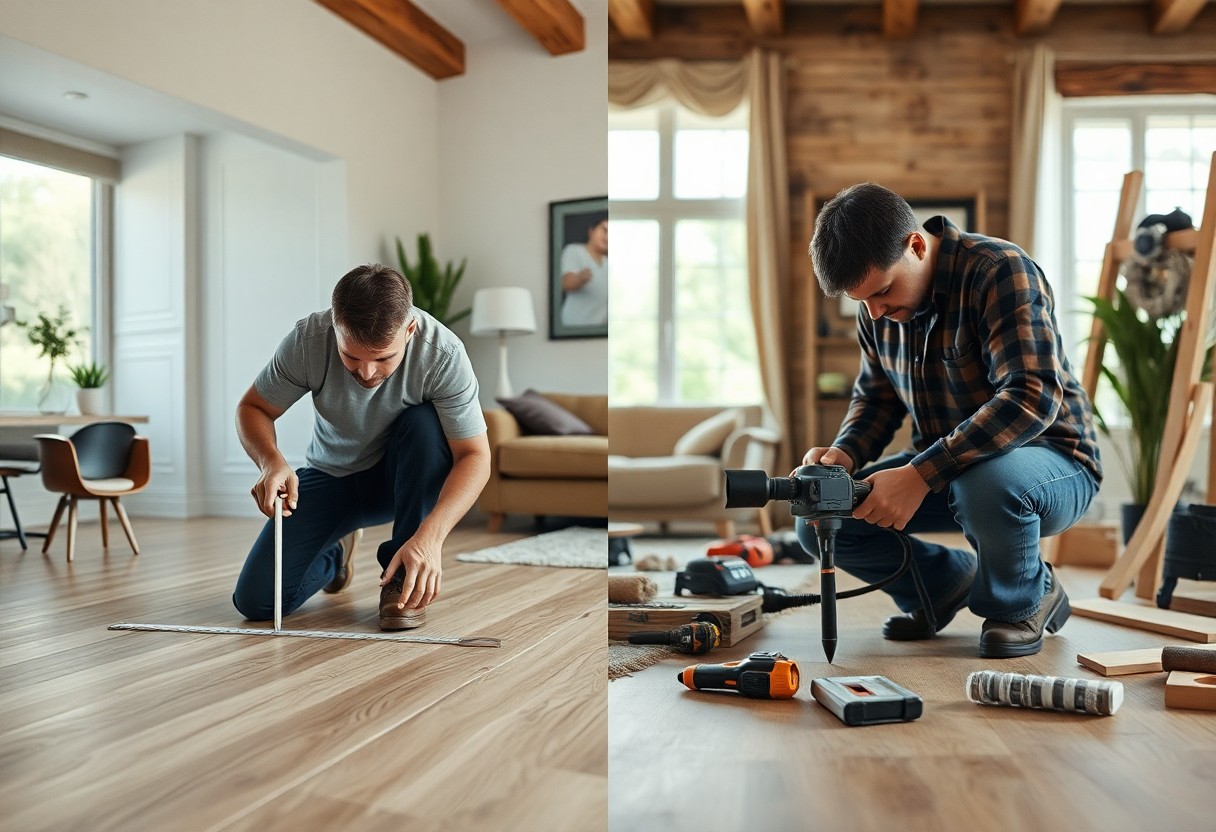Most homeowners face the decision of whether to hire professionals or take a DIY approach when it comes to installing white oak flooring. Understanding the pros and cons of each method can help you make an informed choice that aligns with your skills, budget, and timeline. In this post, we’ll explore the advantages of professional installation versus the satisfaction and cost-saving potential of doing it yourself, allowing you to determine which option is best suited for your project and your home.
Weighing the Pros and Cons of Professional Installation
Deciding whether to hire a professional for your white oak flooring installation involves careful consideration of the advantages and disadvantages each option presents. Understanding these can guide you in making an informed choice that suits your particular situation.
| Pros | Cons |
|---|---|
| Expertise and experience ensure quality results. | Higher upfront costs compared to DIY. |
| Professional tools and equipment are used. | Potential scheduling conflicts. |
| Time savings, especially for larger spaces. | Limited control over the process. |
| Warranty options may be available. | Less opportunity for personal involvement. |
| Insurance coverage protects against accidents. | Possible added costs for unforeseen issues. |
Financial Implications: A Deeper Look at Costs
Professional installation costs typically range from $3 to $7 per square foot, which includes not only labor but often also disposal of old flooring and any necessary site preparation. While the initial investment may seem high, consider the savings on potential mistakes and the longevity achieved through expert craftsmanship. In contrast, DIY efforts may save you money upfront but could result in bigger costs if repairs are needed later due to improper installation.
Time and Efficiency: The Value of Professional Labor
Tackling a flooring project as a DIY endeavor may seem appealing, but the time required can be substantial. Professionals can often complete installations in a fraction of the time it would take a novice, as they come equipped with both the skills and tools needed to expedite the process. Furthermore, they know best practices for overcoming unexpected challenges, ensuring you don’t spend extra hours troubleshooting issues that could arise during installation.
Your time is valuable, especially if you’re balancing the installation with other responsibilities. Professionals typically can install flooring in just a few days for average-sized rooms, whereas a DIY project could stretch into several weeks. This factor alone can prove worthwhile; hiring skilled labor not only reduces your stress but also allows you to dedicate your time to other important tasks in your life, enhancing overall efficiency and productivity throughout the project.
Delving into DIY: Skills, Tools, and Time Investment
Choosing the DIY route for your white oak flooring installation can be both rewarding and challenging. You’ll need to assess your skill level, the tools required, and the time you can dedicate to the project. Installing flooring isn’t just a matter of laying down planks; it involves proper preparation, precision, and sometimes even troubleshooting unexpected issues. With the right approach, however, tackling it yourself can lead to a satisfying result and significant savings.
Essential Tools and Materials for Successful Installation
To ensure a smooth installation, gather necessary tools such as a miter saw, nail gun, pry bar, and flooring nails, along with materials like underlayment, adhesive, and, of course, your white oak planks. Investment in high-quality tools can enhance accuracy and efficiency, ultimately impacting the quality of your finished floor. Additionally, a moisture meter will help evaluate humidity conditions, safeguarding your installation from warping and damage.
Skill Development: What You Need to Know Before You Start
Acquiring the skills for DIY flooring installation involves more than just familiarity with tools; it requires understanding the techniques and methods specific to hardwood flooring. You can learn the basics through online tutorials or local workshops, which will prepare you for tasks like measuring, cutting, and laying down flooring efficiently. Familiarity with your flooring’s characteristics will also help you handle unique challenges, such as uneven subfloors or acclimation needs.
For instance, measuring accurately is fundamental; one miscalculation can throw off your entire layout, leading to wasted materials and increased frustration. While hands-on experience is invaluable, understanding the foundational principles behind hardwood flooring installation will dramatically boost your confidence and capability. Additionally, practicing on scrap pieces of oak can help you refine your cutting and nailing techniques, ensuring you’re more than prepared when it’s time to tackle your living space.
Common Pitfalls: What to Avoid in both Scenarios
Avoiding common pitfalls can save you time and money in your white oak flooring installation project. For professionals, ensure they have the right credentials and positive reviews; a poor choice may lead to botched installation. If you decide to go the DIY route, ensure you have adequate room acclimatization and understand the subfloor requirements to prevent future issues like warping or uneven surfaces.
Mistakes that Could Cost You More Than You Save
Costly mistakes are often made by both professionals and DIY enthusiasts. For instance, failing to measure your space accurately can lead to buying excess materials, wasting money. Additionally, the lack of experience might result in miscalculating the amount of flooring needed, which could leave you with incomplete areas and an increased budget for last-minute purchases.
Product Selection: Quality Versus Affordability
Navigating the balance between quality and affordability is crucial in product selection. While it can be tempting to opt for cheaper options, low-quality materials can lead to premature wear and a lack of aesthetic appeal. Investing in better-quality white oak flooring not only enhances the beauty of your home but also increases its value over time, making it a worthwhile consideration.
Selecting the right flooring material can significantly impact your installation experience and the longevity of your floors. Higher-end white oak options may offer better finishes, durability, and warranty options. While the initial cost is higher, quality products often require less maintenance and can resist scratches and dents, meaning you spend less on repairs down the line. A good rule of thumb is to consult reviews on specific brands and products to gauge long-term satisfaction before making your choice.
The Long-Term Impact: Durability and Maintenance Considerations
Choosing between professional installation and a DIY approach significantly influences the durability and maintenance of your white oak flooring. High-quality installation techniques not only ensure an aesthetically pleasing result but also enhance the floor’s lifespan. Professionals bring expertise in material handling and installation methods that maximize the strength and stability of the flooring, reducing the risk of issues such as warping or gapping over time. In contrast, a DIY setup could introduce errors that may diminish long-term performance and necessitate more frequent repairs or replacements.
How Installation Method Affects Longevity
Your choice of installation method directly impacts the longevity of your white oak flooring. Professional installers have the training and tools to ensure correct subfloor preparation, moisture control, and movement allowance, all vital for maintaining the floor’s integrity. On the other hand, if you decide to go the DIY route, any miscalculations in these factors can lead to problems down the line, such as compromised structural stability and accelerated wear, ultimately shortening your flooring’s life span.
Maintenance Needs: Professional Care Vs. DIY Solutions
The maintenance requirements of your white oak flooring will differ based on whether you opt for professional or DIY installation. Professionals typically offer warranties that cover maintenance services, ensuring your flooring remains in optimal condition. Conversely, DIY solutions may save initial costs, but they often rely on your commitment to regular upkeep, such as refinishing and addressing signs of wear. Without expert assistance, minor issues can escalate, leading to expensive repairs down the road.
Engaging a professional installer often comes with ongoing support, like periodic assessments and guidance on proper care techniques tailored to your specific flooring type. This can be invaluable in extending the life of your flooring and keeping it looking pristine. If you choose to handle maintenance yourself, investing time in learning about the right products and techniques becomes imperative to prevent damage. Regular cleaning, conditioning, and timely repairs will be vital to preserving your floor’s beauty and ensuring its long-term functionality. Balancing these maintenance strategies can greatly impact your white oak flooring’s durability and aesthetic appeal over the years.

Making the Choice: Factors to Consider When Deciding
- Your budget and financial flexibility
- Available time to dedicate to the project
- Your skill level in home improvement tasks
- Access to necessary tools and equipment
- Desired level of finish quality and durability
Assume that each of these factors plays a significant role in your decision-making process; weighing them will help you determine the best installation route for your white oak flooring.
Assessing Your Own Skills and Resources
Your experience with home improvement projects heavily influences whether a DIY approach is feasible. If you’ve handled flooring installs or similar tasks in the past, you might feel confident tackling this job yourself. However, consider the tools you have access to; professional installations often require specialized equipment. Without the right skills and resources, you may face setbacks that cost time and money, negating any savings from a DIY project.
Evaluating the Value of Expert Guidance
Seeking assistance from professionals can offer you peace of mind and foster a better final result. Professional installers bring years of expertise to the table, ensuring that your white oak flooring is installed correctly, avoiding common pitfalls. They have a keen understanding of subfloor analysis, acclimatization requirements, and the intricacies of floor layouts that may not be evident to a DIYer. Additionally, hiring experts can often expedite the installation process, meaning you can enjoy your new flooring sooner.
The financial investment in professional help could pay off significantly. Professionals can complete the job in a fraction of the time it may take for someone less experienced, thus reducing your overall project duration. Moreover, their familiarity with various types of flooring and installation methods positions them to recommend the ideal approach tailored to your space. This knowledge not only enhances the aesthetic appeal but also aims for longevity in your flooring, safeguarding against future costs associated with premature wear or installation errors.
Conclusion
Considering all points, deciding between professional and DIY white oak flooring installation ultimately depends on your skills, time availability, and budget. If you possess sufficient experience and are confident in your abilities, a DIY approach can save you money while allowing for personal customization. However, opting for professional installation ensures a high-quality finish and less stress, especially if you’re unfamiliar with the process. Evaluate your situation and choose the option that best aligns with your preferences and requirements for a successful flooring project.





